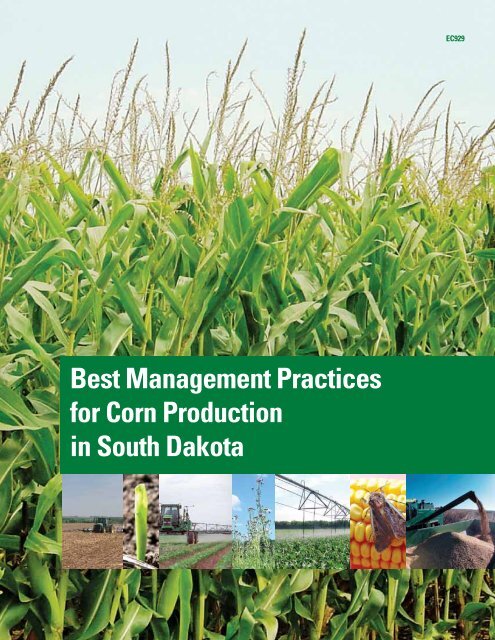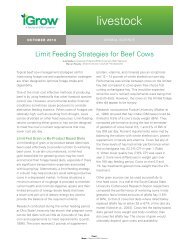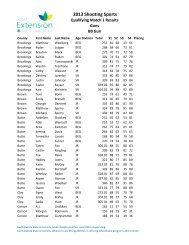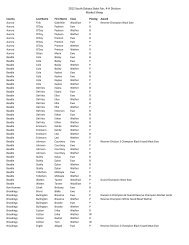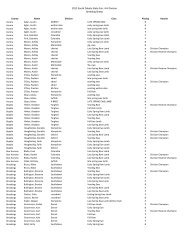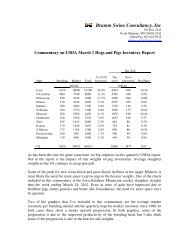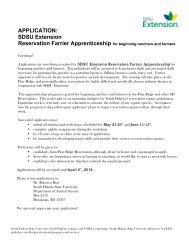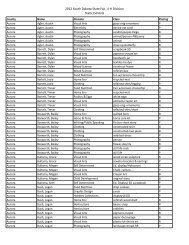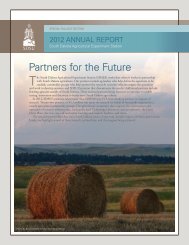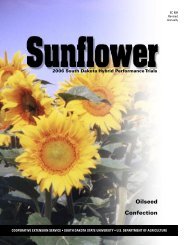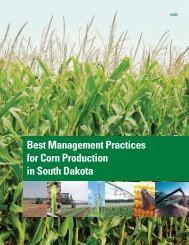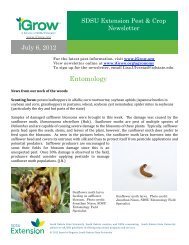Best Management Practices for Corn Production in South Dakota
Best Management Practices for Corn Production in South Dakota
Best Management Practices for Corn Production in South Dakota
You also want an ePaper? Increase the reach of your titles
YUMPU automatically turns print PDFs into web optimized ePapers that Google loves.
<strong>Best</strong> <strong>Management</strong> <strong>Practices</strong><br />
<strong>for</strong> <strong>Corn</strong> <strong>Production</strong><br />
<strong>in</strong> <strong>South</strong> <strong>Dakota</strong><br />
EC929
<strong>Best</strong> <strong>Management</strong> <strong>Practices</strong><br />
<strong>for</strong> <strong>Corn</strong> <strong>Production</strong><br />
<strong>in</strong> <strong>South</strong> <strong>Dakota</strong><br />
®<br />
<strong>South</strong> <strong>Dakota</strong> State University is an Affirmative Action/Equal Opportunity<br />
Employer and offers all benefits, services, education, and employment<br />
without regard <strong>for</strong> race, color, creed, religion, national orig<strong>in</strong>, ancestry,<br />
citizenship, age, gender, sexual orientation, disability, or Vietnam Era<br />
veteran status.<br />
––––––––––––––––––––––––––––––––––––––––––––––––––––––––––––––––––––––––––––––––––––––<br />
Support <strong>for</strong> this document was provided by <strong>South</strong> <strong>Dakota</strong> State University, <strong>South</strong> <strong>Dakota</strong> Cooperative<br />
Extension Service, <strong>South</strong> <strong>Dakota</strong> Agricultural Experiment Station; <strong>South</strong> <strong>Dakota</strong> <strong>Corn</strong> Utilization<br />
Council; USDA-CSREES-406; <strong>South</strong> <strong>Dakota</strong> Department of Environment and Natural Resources<br />
through EPA-319; <strong>South</strong> <strong>Dakota</strong> USGS Water Resources Institute; USDA-North Central Region SARE<br />
program; Colorado <strong>Corn</strong> Growers Association; and Colorado State University.<br />
––––––––––––––––––––––––––––––––––––––––––––––––––––––––––––––––––––––––––––––––––––––<br />
Published by <strong>South</strong> <strong>Dakota</strong> State University, College of Agriculture and Biological Sciences,<br />
AgBio Communications Unit, Box 2218A, Brook<strong>in</strong>gs, <strong>South</strong> <strong>Dakota</strong> 57007<br />
© 2009 by <strong>South</strong> <strong>Dakota</strong> State University, Brook<strong>in</strong>gs, <strong>South</strong> <strong>Dakota</strong><br />
All rights reserved, <strong>in</strong>clud<strong>in</strong>g the right to reproduce any part of this book <strong>in</strong> any <strong>for</strong>m, except brief<br />
quotations, without premission of the publisher.<br />
––––––––––––––––––––––––––––––––––––––––––––––––––––––––––––––––––––––––––––––––––––––<br />
EC929. 2,000 copies pr<strong>in</strong>ted and distributed by <strong>South</strong> <strong>Dakota</strong> Cooperative Extension Service at a cost of<br />
$8.68 each. May 2009.
ii<br />
About 5 million acres of <strong>South</strong> <strong>Dakota</strong> land—close to 10% of<br />
our state’s land resources—are devoted to corn production. This<br />
fact alone makes it clear just how important corn production is<br />
to the economy of the state of <strong>South</strong> <strong>Dakota</strong>. But throw <strong>in</strong> recent<br />
developments <strong>in</strong> <strong>South</strong> <strong>Dakota</strong>’s corn-based ethanol <strong>in</strong>dustry, and<br />
the result is an even further elevation of corn—an elevation to a<br />
most prom<strong>in</strong>ent position with<strong>in</strong> the economy of our state.<br />
For the last century, the <strong>in</strong>tensity of farm<strong>in</strong>g management has<br />
cont<strong>in</strong>ued to escalate. This best management practices manual has<br />
brought together some of the best of both old and new technology.<br />
It is my belief that this manual will be a significant<br />
reference and resource <strong>for</strong> every <strong>South</strong> <strong>Dakota</strong> corn producer.<br />
To all who participated <strong>in</strong> the development of <strong>Best</strong> <strong>Management</strong> <strong>Practices</strong> <strong>for</strong> <strong>Corn</strong><br />
<strong>Production</strong> <strong>in</strong> <strong>South</strong> <strong>Dakota</strong>, I both extend my appreciation and offer a commendation<br />
<strong>for</strong> a job well done.<br />
Latif Lighari, Ph.D.<br />
Associate Dean and Director<br />
<strong>South</strong> <strong>Dakota</strong> State University<br />
<strong>South</strong> <strong>Dakota</strong> Cooperative Extension Service<br />
Professor of Agricultural Education<br />
College of Agriculture and Biological Sciences<br />
<strong>South</strong> <strong>Dakota</strong> corn producers are some of the most productive<br />
<strong>in</strong> the nation. Our state ranked sixth <strong>in</strong> the nation <strong>in</strong> production<br />
of corn <strong>for</strong> gra<strong>in</strong> <strong>in</strong> 2007 and has led the nation <strong>in</strong> planted acres of<br />
genetically eng<strong>in</strong>eered corn hybrids s<strong>in</strong>ce 2000. And yet, our corn<br />
producers face many challenges each year. Each producer must<br />
make the best decision on which corn hybrid to plant, choose the<br />
best fertilizer program, manage high <strong>in</strong>put costs, expect seasonal<br />
hazards, deal with weeds and pests, and market the harvest <strong>for</strong> the<br />
greatest profit.<br />
This manual presents the best management practices developed<br />
<strong>for</strong> the chang<strong>in</strong>g environment of corn production agriculture<br />
<strong>in</strong> <strong>South</strong> <strong>Dakota</strong>. From detailed, basic <strong>in</strong><strong>for</strong>mation on<br />
corn growth and development, through each phase of the corn<br />
production process, the authors and contributors have provided corn producers with an<br />
up-to-date and <strong>in</strong>valuable reference tool.<br />
I extend my congratulations to the editors, reviewers, authors, and contributors <strong>for</strong><br />
a job well done.<br />
Bill Even<br />
<strong>South</strong> <strong>Dakota</strong> Secretary of Agriculture
Editors<br />
David E. Clay, Kurtis D. Reitsma, and Sharon A. Clay<br />
Plant Science Department, <strong>South</strong> <strong>Dakota</strong> State University<br />
Brook<strong>in</strong>gs, <strong>South</strong> <strong>Dakota</strong> 57007<br />
For <strong>in</strong><strong>for</strong>mation, contact david.clay@sdstate.edu.<br />
Coord<strong>in</strong>ation, Manuscript Edit<strong>in</strong>g, and Graphic Design<br />
Eric Ollila , Publication Coord<strong>in</strong>ator-Editor<br />
Terry Molengraaf, In<strong>for</strong>mation Officer<br />
AgBio Communications Unit<br />
College of Agriculture and Biological Sciences, <strong>South</strong> <strong>Dakota</strong> State University<br />
Brook<strong>in</strong>gs, <strong>South</strong> <strong>Dakota</strong> 57007<br />
Reviewers, Authors, and Contributors (alphabetical order)<br />
Troy Bauder, Research Scientist Department of Soil & Crop Science, Colorado State University<br />
Dwayne L. Beck, Research Manager <strong>Dakota</strong> Lakes Research Farm, <strong>South</strong> <strong>Dakota</strong> State University<br />
Sue L. Blodgett, Department Head Plant Science Department, <strong>South</strong> <strong>Dakota</strong> State University<br />
C. Gregg Carlson, Agronomist Plant Science Department, <strong>South</strong> <strong>Dakota</strong> State University<br />
Michael A. Catangui, Entomologist Cooperative Extension Service, <strong>South</strong> <strong>Dakota</strong> State University<br />
David E. Clay, Soil Scientist Plant Science Department, <strong>South</strong> <strong>Dakota</strong> State University<br />
Sharon A. Clay, Weed Scientist Plant Science Department, <strong>South</strong> <strong>Dakota</strong> State University<br />
Darrell L. Deneke, IPM Specialist Cooperative Extension Service, <strong>South</strong> <strong>Dakota</strong> State University<br />
Mart<strong>in</strong> A. Draper, Plant Pathologist Cooperative State Research, Education, and Extension Service<br />
B. Wade French, Entomologist Agricultural Research Service, United States Department of Agriculture<br />
Billy W. Fuller, Entomologist Plant Science Department, <strong>South</strong> <strong>Dakota</strong> State University<br />
Robert G. Hall, Agronomist Cooperative Extension Service, <strong>South</strong> <strong>Dakota</strong> State University<br />
Curt A. Hoffbeck, Agronomist Pioneer Hi-Bred International<br />
Daniel S. Humburg, Biosystems Eng<strong>in</strong>eer Agricultural and Biosystems Eng<strong>in</strong>eer<strong>in</strong>g Dept., <strong>South</strong> <strong>Dakota</strong> State University<br />
Marie A. Langham, Plant Pathologist Plant Science Department, <strong>South</strong> <strong>Dakota</strong> State University<br />
Douglas D. Malo, Soil Scientist Plant Science Department, <strong>South</strong> <strong>Dakota</strong> State University<br />
Mike J. Moechnig, Weed Scientist Cooperative Extension Service, <strong>South</strong> <strong>Dakota</strong> State University<br />
Richard E. Nicolai, Biosystems Eng<strong>in</strong>eer Agricultural and Biosystems Eng<strong>in</strong>eer<strong>in</strong>g Dept., <strong>South</strong> <strong>Dakota</strong> State University<br />
Kurtis D. Reitsma, Agronomist Plant Science Department, <strong>South</strong> <strong>Dakota</strong> State University<br />
Bradley E. Ruden, Plant Pathologist Plant Diagnostic Cl<strong>in</strong>ic, <strong>South</strong> <strong>Dakota</strong> State University<br />
Thomas E. Schumacher, Soil Scientist Plant Science Department, <strong>South</strong> <strong>Dakota</strong> State University<br />
Dennis P. Todey, Climatologist State Climate Office, <strong>South</strong> <strong>Dakota</strong> State University<br />
Todd P. Trooien, Biosystems Eng<strong>in</strong>eer Agricultural and Biosystems Eng<strong>in</strong>eer<strong>in</strong>g Dept., <strong>South</strong> <strong>Dakota</strong> State University<br />
Hal D. Werner, Biosystems Eng<strong>in</strong>eer Agricultural and Biosystems Eng<strong>in</strong>eer<strong>in</strong>g Dept., <strong>South</strong> <strong>Dakota</strong> State University<br />
James A. Wilson, Pesticide Specialist Cooperative Extension Service, <strong>South</strong> <strong>Dakota</strong> State University<br />
Howard J. Woodard, Soil Scientist Plant Science Department, <strong>South</strong> <strong>Dakota</strong> State University<br />
Leon J. Wrage, Weed Scientist Plant Science Department, <strong>South</strong> <strong>Dakota</strong> State University<br />
Recognition and Acknowledgements:<br />
<strong>South</strong> <strong>Dakota</strong> <strong>Corn</strong> Utilization Council<br />
<strong>South</strong> <strong>Dakota</strong> Department of Agriculture<br />
<strong>South</strong> <strong>Dakota</strong> Department of Environment and Natural Resources<br />
Cover photos: USDA-NRCS and Kurtis D. Reitsma.<br />
iii
CHAPTER 8<br />
<strong>Corn</strong> Insect Pests<br />
Historically, the major corn <strong>in</strong>sect pests have been corn rootworms (northern and western), European<br />
corn borer, and black cutworm. Bt-corn hybrids are effective aga<strong>in</strong>st most of these pests. However,<br />
Bt-corn hybrids are not effective aga<strong>in</strong>st corn leaf aphid, corn root aphid, sap beetles, corn rootworm<br />
adults, grasshoppers, white grubs, wireworms, seed corn beetle, and seed corn maggots. These <strong>in</strong>sect<br />
pests can reduce corn yields. This chapter discusses the management and biology of important corn<br />
<strong>in</strong>sect pests commonly observed <strong>in</strong> <strong>South</strong> <strong>Dakota</strong>.<br />
<strong>Corn</strong> Rootworms (Diabrotica barberi and Diabrotica virgifera virgifera)<br />
Pest highlights<br />
ern<br />
corn rootworm and western corn rootworm.<br />
Bt-corn hybrids with the Bt-rootworm gene are<br />
effective aga<strong>in</strong>st corn rootworm larvae.<br />
<br />
corn rootworms.<br />
<br />
<strong>in</strong>sect pests of cont<strong>in</strong>uous corn <strong>in</strong> <strong>South</strong> <strong>Dakota</strong>.<br />
Rootworm description<br />
Adult northern corn rootworm beetles are approximately<br />
¼-<strong>in</strong>ch long and greenish to yellowish <strong>in</strong> color,<br />
while western corn rootworm beetles are yellow with<br />
black longitud<strong>in</strong>al mark<strong>in</strong>gs on their w<strong>in</strong>gs (fig. 8.1).<br />
Larvae of both species are white with a brown head and<br />
grow to a size of 5 /8 <strong>in</strong>ch (fig. 8.2). Both the larvae and<br />
the adults have chew<strong>in</strong>g mouthparts.<br />
Rootworm biology<br />
Rootworm larvae feed on corn roots and cannot<br />
normally survive on roots of other crops such as soybean,<br />
wheat, sunflower, and alfalfa. This feature makes<br />
crop rotation an excellent control approach. Because<br />
the most common alternative hosts <strong>for</strong> rootworm<br />
larvae are green, yellow, and giant foxtail, the control<br />
of these weed pests is important <strong>for</strong> limit<strong>in</strong>g future<br />
rootworm <strong>in</strong>festations.<br />
Rootworm eggs are laid <strong>in</strong> the soil from late summer<br />
until the female rootworm beetle adults are killed<br />
Figure 8.1. Adult beetles of northern corn rootworm<br />
(top) and western corn rootworm (bottom)<br />
(Photo courtesy of Mike Catangui, <strong>South</strong> <strong>Dakota</strong> State University)<br />
Figure 8.2. Larvae and pupae of corn rootworms<br />
(Photo courtesy of Mike Catangui, <strong>South</strong> <strong>Dakota</strong> State University)<br />
CHAPTER 8: <strong>Corn</strong> Insect Pests 49
50<br />
Figure 8.3. Life cycle of the western corn rootworm <strong>in</strong> <strong>South</strong> <strong>Dakota</strong><br />
by the first kill<strong>in</strong>g frost (fig. 8.3). In <strong>South</strong> <strong>Dakota</strong>,<br />
rootworm eggs are primarily laid <strong>in</strong> cornfields, where<br />
they overw<strong>in</strong>ter <strong>in</strong> the soil. Fields where corn was the<br />
previous crop will most likely have rootworm eggs<br />
wait<strong>in</strong>g <strong>for</strong> the new corn crop. Eggs hatch as soon as<br />
corn roots start grow<strong>in</strong>g. Most <strong>in</strong>juries by rootworm<br />
larvae occur <strong>in</strong> June and July (a period of active root<br />
growth). Larvae trans<strong>for</strong>m <strong>in</strong>to pupae <strong>in</strong> mid-July, and<br />
adult rootworm beetles emerge from the soil start<strong>in</strong>g<br />
from late July through August. Adult beetles feed on<br />
corn pollen, silk, and on the leaves of corn, soybeans,<br />
sunflowers, and garden flowers.<br />
In the larval stage, root feed<strong>in</strong>g reduces water and<br />
nutrient <strong>in</strong>take (fig. 8.4) and can result <strong>in</strong> lodg<strong>in</strong>g (fig.<br />
8.5). Lodged corn is difficult to harvest, decreas<strong>in</strong>g harvest<br />
efficiency. Yield losses can be m<strong>in</strong>imized by us<strong>in</strong>g<br />
Bt-corn hybrids, granular and liquid <strong>in</strong>secticides, and<br />
seed treatments.<br />
<strong>Management</strong>: Bt-corn hybrids<br />
Genetically eng<strong>in</strong>eered corn hybrids with Yield-<br />
Gard® Rootworm, YieldGard® Plus, YieldGard® VT<br />
Triple, Herculex® RW, Herculex® XTRA, and Agrisure®<br />
RW genes are resistant to feed<strong>in</strong>g by rootworm larvae<br />
(Table 8.1). These Bt-corn hybrids produce prote<strong>in</strong>s<br />
toxic to rootworm larvae. To prevent the development<br />
of <strong>in</strong>sect resistance to Bt-corn, growers must seed at<br />
least 20% of a field with non-Bt-corn hybrids, thus<br />
creat<strong>in</strong>g a refuge area.<br />
CHAPTER 8: <strong>Corn</strong> Insect Pests<br />
April May June July August September October November – March<br />
Pupa<br />
Larvae<br />
Adult<br />
Eggs Eggs<br />
(Photos courtesy of<br />
University of Nebraska)<br />
Figure 8.4. Root prun<strong>in</strong>g caused by rootworm<br />
larvae on corn<br />
(Photo courtesy of Mike Catangui, <strong>South</strong> <strong>Dakota</strong> State University)<br />
Figure 8.5. Lodg<strong>in</strong>g, or “gooseneck<strong>in</strong>g,”<br />
of corn plants as a result of rootworm <strong>in</strong>juries<br />
(Photo courtesy of Mike Catangui, <strong>South</strong> <strong>Dakota</strong> State University)
Table 8.1. Bt-corn genes that confer resistance to corn aga<strong>in</strong>st <strong>in</strong>sects<br />
Bt gene trademark Bt prote<strong>in</strong>s Company Target <strong>in</strong>sects<br />
Agrisure® RW Syngenta Seeds corn rootworm larvae<br />
<br />
<br />
Rootworm<br />
worm<br />
Dow AgroSciences and<br />
<br />
corn rootworm larvae<br />
corn rootworm larvae<br />
corn rootworm larvae<br />
Syngenta Seeds corn borer larvae<br />
<br />
<br />
Borer<br />
Dow AgroSciences and<br />
<br />
corn borer, black cutworm,<br />
and western bean<br />
cutworm larvae<br />
corn borer larvae<br />
Syngenta Seeds<br />
<br />
Dow AgroSciences and<br />
<br />
<br />
<br />
More <strong>in</strong><strong>for</strong>mation about Bt genes is available at the follow<strong>in</strong>g:<br />
Agrisure - http://www.agrisuretraits.com<br />
<br />
<br />
corn borer and<br />
corn rootworm larvae<br />
corn borer, black cutworm,<br />
western bean cutworm,<br />
and corn rootworm larvae<br />
corn borer and<br />
corn rootworm larvae<br />
corn borer and<br />
corn rootworm larvae<br />
Rootworm seed treatments<br />
Insecticidal seed treatments available to corn growers are clothianid<strong>in</strong> (Poncho®), imidacloprid<br />
(Gaucho®, Prescribe®), or thiamethoxam (Cruiser®). These systemic <strong>in</strong>secticide seed treatments are<br />
applied to seed be<strong>for</strong>e bagg<strong>in</strong>g and sale.<br />
Rootworm <strong>in</strong>secticides<br />
Granular or liquid rootworm <strong>in</strong>secticides are applied <strong>in</strong>-furrow or very close to the seed furrow<br />
dur<strong>in</strong>g plant<strong>in</strong>g. Many different <strong>in</strong>secticides can be used <strong>for</strong> rootworm larval control. In<strong>for</strong>mation<br />
about these control agents is available at the SDSU Extension Entomology Web site (http://plantsci.<br />
sdstate.edu/ent).<br />
Scout<strong>in</strong>g and economic threshold<br />
<strong>Corn</strong> ears dur<strong>in</strong>g the R1 to R2 (silk<strong>in</strong>g to blister) stages may be scouted <strong>for</strong> adult beetles to predict<br />
the potential <strong>for</strong> rootworm <strong>in</strong>festation the follow<strong>in</strong>g season. In cont<strong>in</strong>uous corn, an average of 3 beetles<br />
per 10 ears exam<strong>in</strong>ed is considered the economic threshold <strong>for</strong> control treatment. More rootworm<br />
scout<strong>in</strong>g <strong>in</strong><strong>for</strong>mation can be found at http://entomology.unl.edu/pmguides/crwlarv.htm.<br />
CHAPTER 8: <strong>Corn</strong> Insect Pests 51
52<br />
European <strong>Corn</strong> Borer (Ostr<strong>in</strong>ia nubilalis)<br />
Pest highlights<br />
tion)<br />
and bivolt<strong>in</strong>e (2 generation) ecotypes.<br />
Bt-corn hybrids with the Bt-corn borer gene are<br />
effective aga<strong>in</strong>st this pest.<br />
<br />
harder to manage than bivolt<strong>in</strong>e corn borers.<br />
<br />
plant.<br />
<strong>Corn</strong> borer description<br />
A fully grown corn borer larva is about 1-<strong>in</strong>ch long.<br />
It has a dark brown head and its body is light tan with<br />
brown spots (fig. 8.6). The adult moth is triangular <strong>in</strong><br />
shape, yellowish <strong>in</strong> color with wavy mark<strong>in</strong>gs on w<strong>in</strong>gs,<br />
and 1/2-<strong>in</strong>ch long (fig. 8.7). Male moths are darker <strong>in</strong><br />
color than female moths.<br />
<strong>Corn</strong> borer biology<br />
<strong>Corn</strong> borers have 4 stages of development: egg,<br />
larva, pupa, and adult. These stages cummulatively represent<br />
1 generation. Larvae have 5 <strong>in</strong>stars (larval stages)<br />
that <strong>in</strong>crease <strong>in</strong> size as the larva develops. At the fifth<br />
<strong>in</strong>star stage, a larva prepares to pupate and become an<br />
adult. <strong>Corn</strong> borers are characterized by their number of<br />
generations with<strong>in</strong> a season. In the northern environment,<br />
there is generally only 1 generation (univolt<strong>in</strong>e);<br />
but <strong>in</strong> central areas of the <strong>Corn</strong> Belt, 2 generations can<br />
be produced each season (bivolt<strong>in</strong>e). In southern areas<br />
of the United States, 3 generations are possible (multivolt<strong>in</strong>e).<br />
Univolt<strong>in</strong>e corn borers (1 generation per year)<br />
The univolt<strong>in</strong>e corn borer occurs <strong>in</strong> the northern<br />
counties of <strong>South</strong> <strong>Dakota</strong> (fig. 8.8). Univolt<strong>in</strong>e corn<br />
borer moths start fly<strong>in</strong>g <strong>in</strong> mid-June. Peak populations<br />
occur <strong>in</strong> mid-July. Moths lay eggs ma<strong>in</strong>ly on the underside<br />
of leaves of pre-tassel<strong>in</strong>g (V18) to tassel<strong>in</strong>g (VT)<br />
corn. Eggs hatch with<strong>in</strong> a week, and the newly hatched<br />
larvae first feed on the leaf collars and then migrate to<br />
the tassels to feed on pollen.<br />
The univolt<strong>in</strong>e larvae stay on the corn plants from June through harvest and overw<strong>in</strong>ter <strong>in</strong> stalk<br />
residues left on the field. They trans<strong>for</strong>m <strong>in</strong>to pupae and moths <strong>in</strong> the follow<strong>in</strong>g spr<strong>in</strong>g.<br />
Bivolt<strong>in</strong>e corn borer (2 generations per year)<br />
In the southern portion of the state, corn borers can have 2 generations (fig. 8.8). These moths start<br />
fly<strong>in</strong>g <strong>in</strong> mid-May and the adult moths lay eggs on the underside of the leaves when corn is between the<br />
V6 to V9 growth stages. Newly hatched larvae first feed <strong>in</strong> the whorl, caus<strong>in</strong>g a “shot-hol<strong>in</strong>g” type <strong>in</strong>jury<br />
that is visible when leaves unfurl (fig. 8.9). Second- and third-<strong>in</strong>star larvae feed on the leaf surface and<br />
midribs, caus<strong>in</strong>g a “w<strong>in</strong>dow pan<strong>in</strong>g” type <strong>in</strong>jury. Fourth-<strong>in</strong>star larvae tunnel <strong>in</strong>to the stalk, molt <strong>in</strong>to a<br />
fifth-<strong>in</strong>star larvae after 10 days, then trans<strong>for</strong>m <strong>in</strong>to pupae after about the same amount of time. Tunnels<br />
<strong>in</strong> the stalk produced by the larvae are very <strong>in</strong>jurious because they <strong>in</strong>terfere with water and nutrient<br />
transport.<br />
CHAPTER 8: <strong>Corn</strong> Insect Pests<br />
Figure 8.6. European corn borer larva<br />
(Photo courtesy of Jon Kieckhefer, <strong>South</strong> <strong>Dakota</strong> State University)<br />
Figure 8.7. European corn borer moths<br />
(Photo courtesy of Mike Catangui, <strong>South</strong> <strong>Dakota</strong> State University)<br />
Figure 8.8. Predicted distribution of univolt<strong>in</strong>e and<br />
bivolt<strong>in</strong>e corn borers <strong>in</strong> <strong>South</strong> <strong>Dakota</strong><br />
One-brood (univolt<strong>in</strong>e) corn borer<br />
Two-brood (bivolt<strong>in</strong>e) corn borer
Adult moths emerge from the stalk after 8 days.<br />
These second-generation moths lay eggs on the underside<br />
of leaves, leaf collars, and ear husks at tassel<strong>in</strong>g<br />
(VT) and silk<strong>in</strong>g (R1) corn. Eggs hatch <strong>in</strong>to secondgeneration<br />
corn borer larvae that burrow <strong>in</strong>to the stalks<br />
and ear shanks and feed on develop<strong>in</strong>g seeds. Fully<br />
grown (fifth-<strong>in</strong>star) larvae overw<strong>in</strong>ter on stalks and<br />
stover left on the field. The w<strong>in</strong>ter survival potential of<br />
larvae <strong>in</strong>creases with the amount of residue rema<strong>in</strong><strong>in</strong>g<br />
<strong>in</strong> the field.<br />
In transition zones, flight paths of univolt<strong>in</strong>e and<br />
bivolt<strong>in</strong>e corn borers converge, and both can exist <strong>in</strong><br />
the same field. This phenomenon has been observed<br />
along the northern border of M<strong>in</strong>nehaha County and<br />
along the southern borders of Lake and Moody counties.<br />
More <strong>in</strong><strong>for</strong>mation about both corn borer moth<br />
flight-monitor<strong>in</strong>g data and corn borer biology can be<br />
found at the SDSU Extension Entomology Web site<br />
(http://plantsci.sdstate.edu/ent/).<br />
<strong>Corn</strong> borer <strong>in</strong>juries to corn<br />
<strong>Corn</strong> borer <strong>in</strong>jury can result <strong>in</strong> stalk breakage,<br />
reduction <strong>in</strong> water and nutrient transport, secondary<br />
<strong>in</strong>fection with stalk rot fungi, and yield loss. Injuries to<br />
ears can result <strong>in</strong> ear drop, reduced gra<strong>in</strong> quality, and<br />
secondary <strong>in</strong>fection with mycotox<strong>in</strong>-produc<strong>in</strong>g fungi.<br />
Figure 8.9. Shot-hole symptoms of corn borer<br />
<strong>in</strong>festations<br />
(Photo courtesy of Mike Catangui, <strong>South</strong> <strong>Dakota</strong> State University)<br />
Table 8.2. Estimated yield loss per corn borer<br />
larva at specific corn growth stages<br />
Growth stage % Yield loss/larva/plant<br />
V10 (mid-whorl) 5.9<br />
V16 (green tassel) 5.0<br />
R1 (pollen shed) 4.0<br />
R2 (blister) 3.1<br />
R4 (dough) 2.4<br />
(After North Central Regional Extension publication No. 327)<br />
Leaf feed<strong>in</strong>g by early <strong>in</strong>star larvae causes shot-hole and w<strong>in</strong>dow-pan<strong>in</strong>g type <strong>in</strong>juries that are usually<br />
not serious enough to reduce photosynthesis. However, these leaf <strong>in</strong>jury symptoms serve as <strong>in</strong>dicators<br />
of the presence of corn borers. The tim<strong>in</strong>g of larval <strong>in</strong>festation affects f<strong>in</strong>al yield (Table 8.2). In general,<br />
the univolt<strong>in</strong>e corn borer is more <strong>in</strong>jurious to corn than the bivolt<strong>in</strong>e corn borer because larvae of the<br />
<strong>for</strong>mer stay <strong>in</strong> the plants the entire season. In bivolt<strong>in</strong>e corn borer, the first-generation larvae are generally<br />
more <strong>in</strong>jurious than the second generation because they occur dur<strong>in</strong>g the plant stage that is more<br />
sensitive to stress.<br />
<strong>Corn</strong> borer management<br />
Bt-corn hybrids with YieldGard® <strong>Corn</strong> Borer, YieldGard® Plus, YieldGard® VT Triple, Herculex® I,<br />
Herculex® XTRA, Agrisure® CB, and Agrisure® CB/RW genes produce Bt prote<strong>in</strong>s <strong>in</strong> their leaves, stalks,<br />
and ears that are toxic to the corn borer larvae. Bt-corn hybrids have per<strong>for</strong>med very well dur<strong>in</strong>g corn<br />
borer outbreaks. However, the severity of corn borer <strong>in</strong>festations fluctuates from year to year.<br />
The decision to deploy Bt-corn hybrids is made be<strong>for</strong>e plant<strong>in</strong>g. There<strong>for</strong>e, techniques are needed to<br />
reduce the economic risk associated with treatment and variety choice decisions.<br />
Bt-corn may be most suitable <strong>for</strong> plant<strong>in</strong>g <strong>in</strong> areas where the univolt<strong>in</strong>e corn borer occurs (fig. 8.8).<br />
This pest is less predictable than the bivolt<strong>in</strong>e corn borer. In bivolt<strong>in</strong>e regions, corn borer outbreaks often<br />
decl<strong>in</strong>e to levels below economic thresholds <strong>in</strong> the year after an outbreak. However, the risk of corn<br />
borers may be sufficient to warrant regular plant<strong>in</strong>g of Bt-corn hybrids if corn follows corn <strong>in</strong> the rotation.<br />
For more <strong>in</strong><strong>for</strong>mation on risk, check the annual corn borer moth flights at the SDSU Extension<br />
Entomology Web site (http://plantsci.sdstate.edu/ent/). To prevent the development of <strong>in</strong>sect resistance<br />
to Bt-corn, growers must plant at least 20% of their corn acres with non-Bt-corn hybrids. In<strong>for</strong>mation<br />
on refuge requirements and <strong>in</strong>sect resistance management can be found at http://www.pioneer.com/<br />
CMRoot/Pioneer/biotech/irm/irmbroch.pdf and at http://www.monsanto.com/monsanto/ag_products/<br />
pdf/stewardship/2008_YieldGard®_irmguide.pdf.<br />
CHAPTER 8: <strong>Corn</strong> Insect Pests 53
54<br />
<strong>Corn</strong> borer scout<strong>in</strong>g and <strong>in</strong>secticides.<br />
Insecticide treatments can be effective aga<strong>in</strong>st corn<br />
borers. <strong>South</strong> <strong>Dakota</strong> State University research <strong>in</strong>dicates<br />
that <strong>in</strong>secticide is an effective control if applied<br />
at the right time and rate. <strong>Corn</strong> properly treated with<br />
<strong>in</strong>sectides often produces yields similar to Bt hybrids.<br />
Scout<strong>in</strong>g is critical to maximize the effectiveness of<br />
<strong>in</strong>secticides (Table 8.3).<br />
Western Bean Cutworm (Striacosta albicosta)<br />
Pest highlights<br />
op<strong>in</strong>g<br />
seeds <strong>in</strong> the corn ears late <strong>in</strong> the season.<br />
Bt-corn hybrids that have Herculex® I and Herculex®<br />
XTRA genes are resistant to this pest.<br />
Bt-corn hybrids with the YieldGard® <strong>Corn</strong> Borer,<br />
YieldGard® Plus, YieldGard® VT Triple, Agrisure®<br />
CB, and Agrisure® CB/RW genes are not effective<br />
aga<strong>in</strong>st this pest.<br />
<br />
<br />
produc<strong>in</strong>g fungi.<br />
Cutworm description<br />
The western bean cutworm larva is about 1¼-<strong>in</strong>ch<br />
long when fully grown and has an orange-brown head,<br />
black dorsal shield beh<strong>in</strong>d the head, and a brownish<br />
body with gray mark<strong>in</strong>gs (figs. 8.10 and 8.11). The<br />
adult moth is about ¾-<strong>in</strong>ch long, brown <strong>in</strong> color, and<br />
has a dist<strong>in</strong>ct white band on the lead<strong>in</strong>g edge of its <strong>for</strong>ew<strong>in</strong>gs<br />
(fig. 8.12).<br />
Cutworm biology<br />
In <strong>South</strong> <strong>Dakota</strong>, western bean cutworm moths<br />
start fly<strong>in</strong>g <strong>in</strong> early July and reach peak numbers dur<strong>in</strong>g<br />
the third or fourth week of July, when corn is between<br />
the VT (tassel<strong>in</strong>g) and R1 (silk<strong>in</strong>g) stages. The moths<br />
lay eggs on the upper surface of the leaves <strong>in</strong> the upper<br />
canopy. The eggs hatch with<strong>in</strong> a week and the first<strong>in</strong>star<br />
larvae beg<strong>in</strong> migrat<strong>in</strong>g toward the develop<strong>in</strong>g<br />
ears near egg sites. Larvae usually go through 5 <strong>in</strong>stars,<br />
or stages. The third- through fifth-<strong>in</strong>star larvae feed<br />
on develop<strong>in</strong>g kernels <strong>for</strong> approximately 1 month (fig.<br />
8.11), then migrate to the soil where they prepare <strong>for</strong><br />
overw<strong>in</strong>ter<strong>in</strong>g. Once <strong>in</strong> the soil, the larvae construct<br />
earthen cells 5 to 10 <strong>in</strong>ches belowground <strong>in</strong> which to<br />
overw<strong>in</strong>ter.<br />
Western bean cutworm <strong>in</strong>juries to corn<br />
Several cutworm larvae can feed simultaneously on a<br />
s<strong>in</strong>gle ear. Early studies <strong>in</strong> Colorado <strong>in</strong>dicate that direct<br />
feed<strong>in</strong>g on the develop<strong>in</strong>g ears can result <strong>in</strong> up to 40%<br />
loss <strong>in</strong> gra<strong>in</strong> yield. Injured ears may also be susceptible<br />
to <strong>in</strong>fection with mycotox<strong>in</strong>-produc<strong>in</strong>g fungi (fig. 8.11).<br />
CHAPTER 8: <strong>Corn</strong> Insect Pests<br />
Table 8.3. <strong>Corn</strong> borer scout<strong>in</strong>g, tim<strong>in</strong>g, and<br />
additional <strong>in</strong><strong>for</strong>mation<br />
Look <strong>for</strong> egg masses, newly hatched larvae, and<br />
signs of <strong>in</strong>jury on leaves:<br />
V8-V14 (mid- to late-whorl) <strong>for</strong> 1st-generation<br />
bivolt<strong>in</strong>e corn borer<br />
V16-R1 (green tassel through pollen shed)<br />
<strong>for</strong> univolt<strong>in</strong>e corn borer<br />
R1-R2 (silk<strong>in</strong>g through blister) <strong>for</strong> 2nd-generation<br />
bivolt<strong>in</strong>e corn borer<br />
Details <strong>for</strong> calculat<strong>in</strong>g economic thresholds and<br />
a list of labeled <strong>in</strong>secticides <strong>for</strong> corn borers can<br />
be found at the SDSU Extension Entomology<br />
Web site (http://plantsci.sdstate.edu/ent/).<br />
Figure 8.10. Western bean cutworm larva<br />
(Photo courtesy of Mike Catangui, <strong>South</strong> <strong>Dakota</strong> State University)<br />
Figure 8.11. Western bean cutworm <strong>in</strong>jury<br />
(Photo courtesy of Mike Catangui, <strong>South</strong> <strong>Dakota</strong> State University)<br />
Figure 8.12. Western bean cutworm moth<br />
(Photo courtesy of Mike Catangui, <strong>South</strong> <strong>Dakota</strong> State University)
Western bean cutworm management<br />
Bt-corn hybrids with Herculex® I and Herculex® X-TRA genes produce the Cry1F prote<strong>in</strong> that<br />
provides resistance to western bean cutworm larvae. However, Bt-corn hybrids with YieldGard® <strong>Corn</strong><br />
Borer, YieldGard® Plus, YieldGard® VT Triple, Agrisure® CB, and Agrisure® CB/RW genes do not provide<br />
resistance to western bean cutworm larvae.<br />
Western cutworm scout<strong>in</strong>g and <strong>in</strong>secticides<br />
Scout<strong>in</strong>g <strong>for</strong> western bean cutworms should start at the V16 (green tassel) stage and cont<strong>in</strong>ue<br />
through the R3 (milk) stage. Eggs and newly hatched larvae are usually found <strong>in</strong> the silks or leaves <strong>in</strong><br />
the upper canopy. Because the tim<strong>in</strong>g of spray application is very important (the <strong>in</strong>secticide must be<br />
applied be<strong>for</strong>e the larvae enter the ears), scout<strong>in</strong>g must also be timed accord<strong>in</strong>gly. At least 100 plants<br />
(10 plants from 10 locations on the field) per 40-acre field must be <strong>in</strong>spected to accurately gauge the<br />
<strong>in</strong>festation level. Both the center and borders of the cornfield must be <strong>in</strong>spected. This pest should be<br />
controlled if 8% of the plants have eggs or newly hatched larvae. For <strong>in</strong>secticides to be effective, the<br />
<strong>in</strong>secticide must be applied be<strong>for</strong>e the larvae enter the ears. In<strong>for</strong>mation on different <strong>in</strong>secticides is<br />
available at the SDSU Extension Entomology Web site (http://plantsci.sdstate.edu/ent/).<br />
Black Cutworm (Agrotis ipsilon)<br />
Pest highlights<br />
<br />
<strong>in</strong> the season.<br />
Bt-corn<br />
hybrids are effective aga<strong>in</strong>st this pest.<br />
<br />
significant stand loss can result.<br />
kota.<br />
Moths migrate <strong>in</strong>to the state <strong>in</strong> early spr<strong>in</strong>g<br />
and are attracted to wet and weedy fields.<br />
Black cutworm description<br />
A full-grown larva is about 1½-<strong>in</strong>ches long, dark<br />
brown to black, and “greasy” <strong>in</strong> appearance (fig. 8.13).<br />
Under the microscope or hand lens, the sk<strong>in</strong> of the<br />
larva has a rough, pebbly texture. The pupa is brown<br />
and about ¾-<strong>in</strong>ch long (fig. 8.13).<br />
Black cutworm biology<br />
Moths start migrat<strong>in</strong>g <strong>in</strong>to <strong>South</strong> <strong>Dakota</strong> from<br />
southern states <strong>in</strong> early April. <strong>South</strong>erly w<strong>in</strong>ds <strong>in</strong>fluence<br />
the transport, distribution, and severity of black<br />
cutworm <strong>in</strong>festations. Eggs are deposited on weeds<br />
and crop residues be<strong>for</strong>e corn is planted. Black cutworm<br />
larvae <strong>in</strong>itially feed on weeds, then move to corn<br />
Figure 8.13. Black cutworm larvae, pupa, and cut<br />
seedl<strong>in</strong>g<br />
(Photo courtesy of Mike Catangui, <strong>South</strong> <strong>Dakota</strong> State University)<br />
Figure 8.14. Miss<strong>in</strong>g corn seedl<strong>in</strong>gs due to black<br />
cutworm <strong>in</strong>jury<br />
(Photo courtesy of Mike Catangui, <strong>South</strong> <strong>Dakota</strong> State University)<br />
seedl<strong>in</strong>gs <strong>in</strong> May through early June. <strong>Corn</strong> seedl<strong>in</strong>gs can be cut underground, below the grow<strong>in</strong>g po<strong>in</strong>t,<br />
result<strong>in</strong>g <strong>in</strong> extensive seedl<strong>in</strong>g stand loss (fig. 8.14).<br />
Black cutworm management<br />
Only Bt-corn hybrids with Herculex® I and Herculex® X-TRA are considered resistant to black<br />
cutworm larvae. Seed treatments of clothianid<strong>in</strong> or thiamethoxam provide protection from cutworm<br />
damage.<br />
Black cutworm scout<strong>in</strong>g and <strong>in</strong>secticides<br />
Scout<strong>in</strong>g <strong>for</strong> black cutworm larvae should start at the VE (germ<strong>in</strong>ation and emergence) stage and cont<strong>in</strong>ue<br />
on through V4 (fourth leaf). Insecticide treatment is recommended if 5% (1 <strong>in</strong> 20) of the seedl<strong>in</strong>gs<br />
show signs of cutt<strong>in</strong>g or leaf feed<strong>in</strong>g and if the larvae are less than 1-<strong>in</strong>ch long. In<strong>for</strong>mation on different<br />
<strong>in</strong>secticides is available at the SDSU Extension Entomology Web site (http://plantsci.sdstate.edu/ent/).<br />
CHAPTER 8: <strong>Corn</strong> Insect Pests 55
56<br />
Sap Beetles (Glischrochilus quadrisignatus,<br />
Carpophilus lugubris, Carpophilus dimidiatus)<br />
Pest highlights<br />
<br />
<br />
with mycotox<strong>in</strong>-produc<strong>in</strong>g fungi.<br />
<br />
<strong>in</strong> <strong>South</strong> <strong>Dakota</strong>.<br />
<br />
unharvested ears.<br />
Sap beetles description<br />
The picnic beetle (G. quadrisignatus) is 1 /3 -<strong>in</strong>ch long<br />
and sh<strong>in</strong>y black with 4 yellowish mark<strong>in</strong>gs on its w<strong>in</strong>gs<br />
(fig. 8.15). The dusky sap beetle (C. lugubris) is dull<br />
brown and 1 /16 -<strong>in</strong>ch long (fig. 8.16). The corn sap beetle<br />
(C. dimidiatus) is 1 /8 -<strong>in</strong>ch long and reddish brown.<br />
Larvae are whitish or p<strong>in</strong>kish and measure ¼-<strong>in</strong>ch long<br />
(fig. 8.17).<br />
Sap beetles biology<br />
Sap beetles can overw<strong>in</strong>ter <strong>in</strong> <strong>South</strong> <strong>Dakota</strong> under<br />
crop residues and <strong>in</strong> unharvested corn ears. Adults<br />
become active <strong>in</strong> the spr<strong>in</strong>g and presumably start feed<strong>in</strong>g<br />
on crop residues and the sap of trees, lay<strong>in</strong>g eggs<br />
near food sources. There are 3 larval <strong>in</strong>stars, and sap<br />
beetles develop from egg to adult <strong>in</strong> about a month.<br />
Several overlapp<strong>in</strong>g generations per grow<strong>in</strong>g season are<br />
possible.<br />
Sap beetle adults appear to be attracted to corn<br />
pollen dur<strong>in</strong>g tassel<strong>in</strong>g and silk<strong>in</strong>g <strong>in</strong> August and follow<br />
corn leaf aphid <strong>in</strong>festations. Eggs may be laid directly on<br />
the develop<strong>in</strong>g corn ears, with larvae and adults feed<strong>in</strong>g<br />
on develop<strong>in</strong>g kernels (figs. 8.15 and 8.17). Direct<br />
feed<strong>in</strong>g by sap beetles does not appear to reduce yield,<br />
but <strong>in</strong>jured ears may become susceptible to mycotox<strong>in</strong>produc<strong>in</strong>g<br />
fungi later <strong>in</strong> the season (fig. 8.18).<br />
Sap beetle management<br />
Most <strong>in</strong>secticides labeled <strong>for</strong> major corn <strong>in</strong>sect pests<br />
are also labeled <strong>for</strong> use aga<strong>in</strong>st sap beetles. Economic<br />
thresholds have not been determ<strong>in</strong>ed. Bt-corn hybrids<br />
currently available are completely <strong>in</strong>effective aga<strong>in</strong>st sap<br />
beetles.<br />
<strong>Corn</strong> Root Aphid (Aphis maidiradicis)<br />
Pest highlights<br />
<br />
cornfield ants.<br />
<br />
<br />
syr<strong>in</strong>ge-like mouthparts.<br />
<br />
CHAPTER 8: <strong>Corn</strong> Insect Pests<br />
Figure 8.15. A picnic (sap) beetle on a corn ear<br />
(Photo courtesy of Jon Kieckhefer, <strong>South</strong> <strong>Dakota</strong> State University)<br />
Figure 8.16. Dusky sap beetles<br />
(Photo courtesy of Mike Catangui, <strong>South</strong> <strong>Dakota</strong> State University)<br />
Figure 8.17. Sap beetle larvae on a corn ear<br />
(Photo courtesy of Mike Catangui, <strong>South</strong> <strong>Dakota</strong> State University)<br />
Figure 8.18. Fungal <strong>in</strong>fection on a corn ear after<br />
sap beetle <strong>in</strong>jury<br />
(Photo courtesy of Mike Catangui, <strong>South</strong> <strong>Dakota</strong> State University)
<strong>Corn</strong> root aphid description<br />
<strong>Corn</strong> root aphids are plump, yellow-green to bluegreen<br />
<strong>in</strong>sects, about 1/16-<strong>in</strong>ch long when fully grown<br />
(fig. 8.19). They have syr<strong>in</strong>ge-like mouthparts to withdraw<br />
sap from the roots. <strong>Corn</strong> root aphids are usually<br />
found underground, clustered around the roots of corn<br />
plants. Individual aphids can either be w<strong>in</strong>ged or w<strong>in</strong>gless,<br />
with the <strong>for</strong>mer usually darker <strong>in</strong> color than the<br />
latter. Stunted and yellowish corn seedl<strong>in</strong>gs, along with<br />
the presence of numerous cornfield ants and ant nests,<br />
may be signs of corn root aphid <strong>in</strong>festations (fig. 8.20).<br />
<strong>Corn</strong> root aphid biology<br />
<strong>Corn</strong> root aphids spend much of their time<br />
underground, feed<strong>in</strong>g on the sap of corn roots. The<br />
honeydew that aphids excrete is used by cornfield ants<br />
as food. There is a symbiotic relationship between the<br />
ants and aphids. Aphids supply food to the ants, while<br />
the ants protect and transport the aphids. Although<br />
the corn root aphid is capable of <strong>for</strong>m<strong>in</strong>g w<strong>in</strong>gs, its<br />
dispersion is aided by cornfield ants. <strong>Corn</strong> root aphids<br />
overw<strong>in</strong>ter as eggs that are cared <strong>for</strong> by cornfield ants<br />
<strong>in</strong> their nests. These eggs hatch <strong>in</strong> the spr<strong>in</strong>g and are<br />
carried by ants to the roots of acceptable available<br />
plants such as smartweed, wheat, and corn. Aphids can<br />
also be carried by the ants from weeds to corn later <strong>in</strong><br />
the season. Like most aphid species, corn root aphids<br />
multiply very fast and complete their life cycles from<br />
nymphs to adults with<strong>in</strong> a week. W<strong>in</strong>ged aphids may<br />
Figure 8.19. <strong>Corn</strong> root aphid adults and nymphs<br />
(Photo courtesy of He<strong>in</strong>richs et al.)<br />
Figure 8.20. Suspected area (due to numerous ant<br />
nests present and corn <strong>in</strong>jury symptoms) of corn<br />
root aphid <strong>in</strong>festation<br />
(Photo courtesy of Roger Barrick, <strong>South</strong> <strong>Dakota</strong> State University)<br />
be produced when a colony becomes overcrowded. High numbers of aphids withdraw<strong>in</strong>g sap from the<br />
roots of corn seedl<strong>in</strong>gs may result <strong>in</strong> the stunt<strong>in</strong>g and yellow<strong>in</strong>g of corn leaves (fig. 8.20).<br />
<strong>Corn</strong> root aphid management<br />
There are currently no economic thresholds or <strong>in</strong>secticides available <strong>for</strong> use aga<strong>in</strong>st corn root<br />
aphids on corn <strong>in</strong> <strong>South</strong> <strong>Dakota</strong>.<br />
<strong>Corn</strong> Leaf Aphid (Rhopalosiphum maidis)<br />
Pest highlights<br />
Figure 8.21. <strong>Corn</strong> leaf aphid adults and nymphs<br />
<br />
and develop<strong>in</strong>g ears.<br />
<br />
poll<strong>in</strong>ation, and ear development.<br />
<br />
corn leaf aphids.<br />
<br />
other pests, such as molds and sap beetles.<br />
<strong>Corn</strong> leaf aphid description<br />
(Photo courtesy of Jon Kieckhefer, <strong>South</strong> <strong>Dakota</strong> State University)<br />
Bluish-green w<strong>in</strong>gless and w<strong>in</strong>ged corn leaf aphids<br />
range <strong>in</strong> size from 1/16 to 1/8 <strong>in</strong>ch (fig. 8.21); both<br />
w<strong>in</strong>gless and w<strong>in</strong>ged <strong>for</strong>ms may be present. <strong>Corn</strong> leaf<br />
aphids can usually be found <strong>in</strong> the whorl, tassel, develop<strong>in</strong>g ears, and upper leaves. Heavily <strong>in</strong>fested<br />
plants may appear “messy” or “sticky” (fig. 8.22).<br />
CHAPTER 8: <strong>Corn</strong> Insect Pests 57
58<br />
<strong>Corn</strong> leaf aphid biology<br />
Figure 8.22. <strong>Corn</strong> leaf aphids on tassel and leaf<br />
<strong>Corn</strong> leaf aphids do not overw<strong>in</strong>ter <strong>in</strong> <strong>South</strong><br />
<strong>Dakota</strong>, because they are killed by frost. W<strong>in</strong>ged adults<br />
arrive <strong>in</strong> June from warmer climates. Once on the corn<br />
plants, the aphids multiply very quickly by giv<strong>in</strong>g birth<br />
to live aphids. Initially the corn whorls are <strong>in</strong>fested, but<br />
as the season progresses the <strong>in</strong>festation spreads to the<br />
emerg<strong>in</strong>g tassels, silk<strong>in</strong>g ears, and upper leaves. The<br />
entire plant potentially can be covered with corn leaf<br />
aphids. Like any other aphid species, corn leaf aphids (Photo courtesy of Mike Catangui, <strong>South</strong> <strong>Dakota</strong> State University)<br />
have syr<strong>in</strong>ge-like mouthparts that they use <strong>for</strong> withdraw<strong>in</strong>g<br />
sap. Partially digested sap is cont<strong>in</strong>uously excreted as honeydew. W<strong>in</strong>ged aphids can migrate<br />
<strong>in</strong>to nearby cornfields. <strong>Corn</strong> leaf aphids can reduce yields by directly <strong>in</strong>terfer<strong>in</strong>g with poll<strong>in</strong>ation and by<br />
caus<strong>in</strong>g plant stress dur<strong>in</strong>g the reproductive stages from VT to silk<strong>in</strong>g.<br />
<strong>Corn</strong> leaf aphid management<br />
<strong>Management</strong> decision-mak<strong>in</strong>g tools are available <strong>for</strong> the corn leaf aphid. In<strong>for</strong>mation <strong>for</strong> scout<strong>in</strong>g<br />
and estimat<strong>in</strong>g economic thresholds is available at http://plantsci.sdstate.edu/ent/.<br />
Additional In<strong>for</strong>mation and References<br />
Catangui, M. A. 2000. European corn borer <strong>in</strong> <strong>South</strong> <strong>Dakota</strong>. <strong>South</strong> <strong>Dakota</strong> State University, Brook<strong>in</strong>gs,<br />
SD. http://plantsci.sdstate.edu/ent/ecb/ecb_mgmt_SD.htm.<br />
Catangui, M. A. 2003. Transgenic Bacillus thur<strong>in</strong>giensis corn hybrid per<strong>for</strong>mance aga<strong>in</strong>st univolt<strong>in</strong>e<br />
ecotype European corn borer (Lepidoptera: Crambidae) <strong>in</strong> <strong>South</strong> <strong>Dakota</strong>. Jour. of Econ. Entomology.<br />
96: 957–68.<br />
Catangui, M. A. and R. K. Berg. 2002. Comparison of Bacillus thur<strong>in</strong>giensis corn hybrids and <strong>in</strong>secticide-treated<br />
isol<strong>in</strong>es exposed to bivolt<strong>in</strong>e European corn borer (Lepidoptera: Crambidae) <strong>in</strong> <strong>South</strong><br />
<strong>Dakota</strong>. Jour. of Econ. Entomology. 95: 155–66.<br />
Catangui, M. A. and R. K. Berg. 2006. Western bean cutworm, Striacosta albicosta (Smith) (Lepidoptera:<br />
Noctuidae), as a potential pest of transgenic Cry 1Ab Bacillus thur<strong>in</strong>giensis corn hybrids <strong>in</strong> <strong>South</strong><br />
<strong>Dakota</strong>. Environmental Entomology. 35: 1439–52.<br />
He<strong>in</strong>richs, E. A., J. E. Foster, and M. E. Rice. 2006. Maize <strong>in</strong>sect pests <strong>in</strong> North America. In: E. B. Radc-<br />
<br />
MN. http://ipmworld.umn.edu.<br />
North Central Regional Extension Publication No. 327. 1998. European corn borer: ecology and management.<br />
Iowa State University, Ames, IA.<br />
Steffey, K. L., M. E. Rice, J. All, D. A. Andow, M. E. Gray, and J. W. Van Duyn (eds.). 1999. Handbook of<br />
<strong>Corn</strong> Insects. Entomological Society of America, Lanham, MD.<br />
––––––––––––––––––––––––––––––––––––––––––––––––––––––––––––––––––––––––––––––––––––––<br />
Catangui, M.A., B.W. Fuller, and B.W. French. 2009. “<strong>Corn</strong> <strong>in</strong>sect pests.” Pp. 49–58. In Clay, D.E., K.D.<br />
Reitsma, and S.A, Clay (eds). <strong>Best</strong> <strong>Management</strong> <strong>Practices</strong> <strong>for</strong> <strong>Corn</strong> <strong>Production</strong> <strong>in</strong> <strong>South</strong> <strong>Dakota</strong>.<br />
EC929. <strong>South</strong> <strong>Dakota</strong> State University, <strong>South</strong> <strong>Dakota</strong> Cooperative Extension Service, Brook<strong>in</strong>gs, SD.<br />
Support <strong>for</strong> this document was provided by <strong>South</strong> <strong>Dakota</strong> State University, <strong>South</strong> <strong>Dakota</strong> Cooperative<br />
Extension Service, <strong>South</strong> <strong>Dakota</strong> Agricultural Experiment Station; <strong>South</strong> <strong>Dakota</strong> <strong>Corn</strong> Utilization<br />
Council; USDA-CSREES-406; <strong>South</strong> <strong>Dakota</strong> Department of Environment and Natural Resources<br />
through EPA-319; <strong>South</strong> <strong>Dakota</strong> USGS Water Resources Institute; USDA-North Central Region SARE<br />
program; Colorado <strong>Corn</strong> Growers Association; and Colorado State University.<br />
The <strong>in</strong><strong>for</strong>mation <strong>in</strong> this chapter is provided <strong>for</strong> educational purposes only. Product trade names<br />
have been used <strong>for</strong> clarity. Any reference to trade names does not imply endorsement by <strong>South</strong> <strong>Dakota</strong><br />
State University, nor is any discrim<strong>in</strong>ation <strong>in</strong>tended aga<strong>in</strong>st any product, manufacturer, or distributor.<br />
The reader is urged to exercise caution <strong>in</strong> mak<strong>in</strong>g purchases or evaluat<strong>in</strong>g product <strong>in</strong><strong>for</strong>mation.<br />
CHAPTER 8: <strong>Corn</strong> Insect Pests


